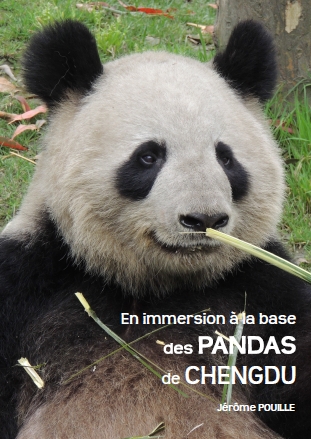Communiqués des zoos > Washington (USA)
Giant panda cub weaning FAQ
Date : 15 mars 2017 | Auteur : National zoological park | Source : Zoo de Washington
The Smithsonian's National Zoo has received good questions about the giant panda weaning process and recent behaviors exhibited by Bei Bei and Mei Xiang. The giant panda science and animal care team put together this FAQ, which includes further context on maternal/cub and pre-estrus behaviors and the history of the giant pandas in the Zoo's care.
When do you wean panda cubs from their mothers at the Smithsonian's National Zoo?
At the Zoo, we wean panda cubs around 18 months of age which has proven successful for the three zoos in the United States who have raised multiple panda cubs.
Why can’t mothers and cubs live together permanently?
Pandas are solitary animals, they do not live in groups. Mothers and cubs do not stay together in the wild. If we were to keep them together much beyond the point when a cub is self-sufficient, that would eventually cause aggression.
What behaviors indicate it is time for a cub to wean from its mother?
The biggest indicator for the cub to separate from its mother is when the cub becomes less dependent on its mother. At that point, the cub is meeting his/her nutritional needs through the consumption of bamboo and other solid foods. Additionally, a cub and mother will spend longer periods of time apart in separate areas of the enclosure.
What are the lessons learned in weaning Bao Bao and Tai Shan that impacted Bei Bei’s weaning process?
We learned that the ambiguity of a drawn-out separation can actually make things more stressful. Once a cub is comfortable and confident in a new yard, it is best to give them independence. There is a period of adjustment, but a clean quick separation is the easiest way for both mother and cub to adjust.
When Mei Xiang and her cub(s) begin living independently, is it stressful for them?
In the wild a cub would move further away from its mother, where it is unable to hear or see her. At the Zoo, we cannot completely mimic the exact conditions. As a result, the first week of weaning may be stressful as the cub and mother adjust to being near to each other, but separated. During the first week of Mei Xiang and Bei Bei living apart, we heard them vocalizing to each other which sometimes agitated them. We also witnessed some restless pacing and climbing which has since abated. During this time, we tried to ease the stress by giving them extra keeper attention.
What do you do for Mei Xiang and her cub(s) to ease the weaning process? How do you respond when you see or hear a behavior that is in response to the separation?
If we see that either panda is agitated, keepers try to calm them either by giving them favorite enrichment items—such as honey on crates and fruitsicles—or engaging in an interaction, like a short training session.
In fact, keepers interact with Bei Bei at least three additional times per day. He is comforted just by seeing his keepers, or by keepers talking to him.
Mei Xiang is more likely to ignore keepers’ efforts to engage her as she is starting to experience hormonal changes as the breeding season gets closer. Additionally, Tian Tian, who lives in the enclosure directly next to hers is in rut and is often vocalizing to her, which can sometimes elicit animated responses from her—all perfectly normal.
What happens to a female after a cub weans?
The female will start cycling again and will go into estrus 40 to 60 days after weaning. Mei Xiang is already showing signs of pre estrus (restlessness, water play, scent-anointing). For pandas, reproduction ends around 20 years old. Mei Xiang is near the end of her reproductive life cycle. However, it is important for the global population of giant pandas that her genes are represented and she has the opportunity to breed again this year.
What’s the difference between a pre-estrus behavior directed towards Tian Tian and a response to Bei Bei?
Mei Xiang’s location and vocalizations are good indicators of whether she is exhibiting a pre-estrus behavior or a response to Bei Bei. A response to Bei Bei would focus on the back wall closest to his enclosures. Her vocalizations are usually high-pitched short chirps. When she responds to Tian Tian, she makes a moaning vocalization at him usually through one of the ‘howdy’ windows between their yards. If she is responding to rut behaviors from Tian Tian, she paces inside her indoor enclosure and outside throughout her yard.
It seems like Bei Bei is less active since weaning and living independently from Mei Xiang. Is that normal?
We witness many of the same behaviors and activity patterns with Bei Bei as we saw before the separation. The one exception is social play, as he does not have access to another panda. He is eating, exploring his yard, and playing and interacting with enrichment. He found a tree that he likes to sleep in and he naps in it regularly both in the morning and afternoon, much like he did while he was still with Mei Xiang.
Why is Bei Bei sometimes climbing a tree near Mei Xiang’s enclosure?
Bei Bei identified a new favorite “napping” tree in his yard that will hold his weight and is close to Mei Xiang’s enclosure. He can see the keepers as well as other parts of the panda habitat when he is in that tree and often climbs it when he hears the keepers in the area.
Bei Bei is spending a lot of time at the fence. Why?
Since the fence is solid, he is not able to see/interact with the keepers like he did when he was in Mei Xiang’s yard. In her yard there is mesh at the back that permits visual access to keepers while they are working. The back corner of Bei Bei’s yard is the closest area to the keepers when they are working near the bamboo shed. Bao Bao also spent time in that corner, especially when she wanted more food or to interact with keepers.
Is the Zoo or the panda team giving Mei Xiang or Bei Bei any type of medication or supplement(s) to control behavior or to impact the breeding process?
Outside of routine vaccinations and deworming drugs (to keep them healthy), the giant pandas do not receive any other medications.




